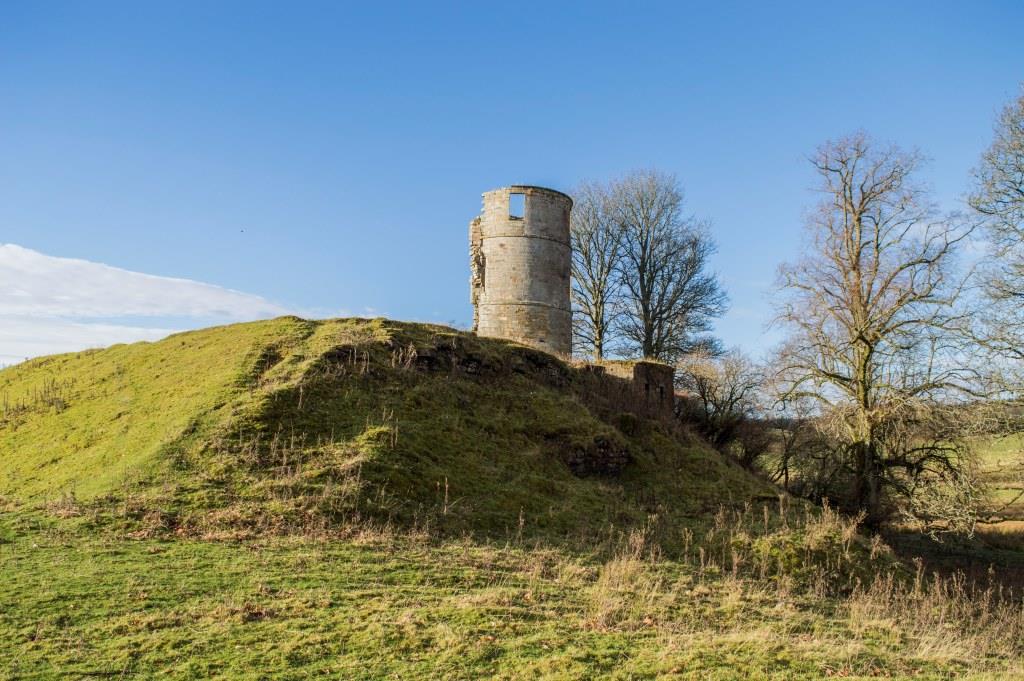Douglas Castle

Douglas Castle Details
Douglas Castle, ruined tower of demolished C18 mansion incorporating C18 tower on site of C13-15 castle of Douglases
- Closest To: Douglas
- Access: Free Public Access
- Grid Reference: NS842318
Douglas Castle was a large and impressive castle that had been rebuilt several times before the castellated mansion that was the last building to hold the name was demolished. All that remains is a single round tower of 17th century style on top of the castle mound. The park is accessible by footpath and the site is accessible to the public.
The lands of Douglas were probably granted to Theobald, a Fleming, in the reign of King David I as part of the extensive resettlement of Lanarkshire in the 12th century. However the first man known to have held the lands is William de Douglas, who was active in the reign of King William the Lion. He and his son increased the family estates and wealth considerably during William’s reign and that of Alexander II, and the grandson, William Longleg, was important enough to have a recorded career supporting the Durwards against the Comyn family during the minority of Alexander III. Longleg obtained lands in Northumberland by marriage, increasing the family wealth still further. It was in the time of Longleg’s son William the Hardy that the first mention of a castle of Douglas is made, and this coincides with the end of a marriage alliance of high order, the daughter of the Steward. Their son was James “the Good” Douglas, the companion of Robert Bruce. In 1288 William abducted Eleanor Ferrers, to the outrage of King Edward I of England, and married her. From this second marriage came Sir Archibald, whose son was the first Earl of Douglas, as well as William’s first imprisonment in England.
During the Wars of Independence, the castle was occupied by the English and sacked by James Douglas, who was an active supporter of Robert Bruce’s destruction policy. His half-brother Archibald, involved in the civil war that followed Bruce’s death in 1329, is unlikely to have changed this approach before his death in 1333, and Archibald’s son, only ten years old at the time, was sent to France with King David to be educated. Upon his return in 1348 he embarked upon a guerilla war that removed the English from Douglasdale. This seems to suggest that the existence of a castle at Douglas is questionable until the 1350s, when Archibald chose to build a new castle at Tantallon. However it was at Douglas that he died in 1384, so he clearly erected a building suitable for an earl to live in by this time.
It is therefore most likely that the late 14th century castle at Douglas would have followed the great tower and courtyard type, exemplified by that of a different Archibald Douglas at Threave. This could have been erected at either the Parkhall site or the site of Douglas Castle. Under later Earls of Douglas, the castle was undoubtedly extended and updated, and although there is no record specifically of the castle being targeted, when King James II suppressed the rebellion of the family, he led a punitive raid into Douglasdale and burned it all. In 1457 Douglas was granted to the earl of Angus, who occupied Tantallon. As the 6th Earl of Angus also fell foul of royalty, it is of interest to note that Douglas Castle fell quickly to the forces of James V, led by the Earl of Argyll in 1528.
In 1530 and 1541 Archibald Symington was Captain of the Castle of Douglas, his son John held the same position in 1556, and John’s grandson, another John, in 1605 and 1612. In 1621 John resigned the position. The family had held the same position under the Earls of Douglas, Thomas Dickson being the first in 1307 (he took the name Symington from the lands granted to him by Bruce in 1317), William in 1419, and John in 1476. Archibald must therefore have been returned to the position by Angus. In the 1590s, Ponts map shows that Douglas Castle existed near the village – and that “The Park” also existed, shown as a small tower. As a matter of interest, a more extensive tower house is shown at Parkhead, further upstream than The Park. Ponts image shows a large and complex structure, similar in some ways to the frontage of the later mansion, with twin towers flanking a central wall with gate, and a hall block behind. Clearly it is this castle that the later John Symingtons knew, but dating it is hard. We might suggest it was built by the Angus Earls, possibly post 1528.
The 11th earl made this Douglas Castle his primary residence, and as this is the tentative date for the round tower, it may be that during his fifty year occupancy he converted it into a more palatial home -perhaps to reflect his title Marquess of Douglas in 1633. His son James lived at Douglas for more than thirty years, dying in 1700, and was succeeded by his six year old son Archibald, created Duke of Douglas in 1703. When the castle burned down in 1755, a new mansion was built on the edge of the castle ground, but it remained incomplete from 1761 to 1877, when the Earl of Hume completed the job upon inheritance. Only 60 years later the castle was demolished over fears of subsidence.
Become a supporter of my work to access a more detailed history